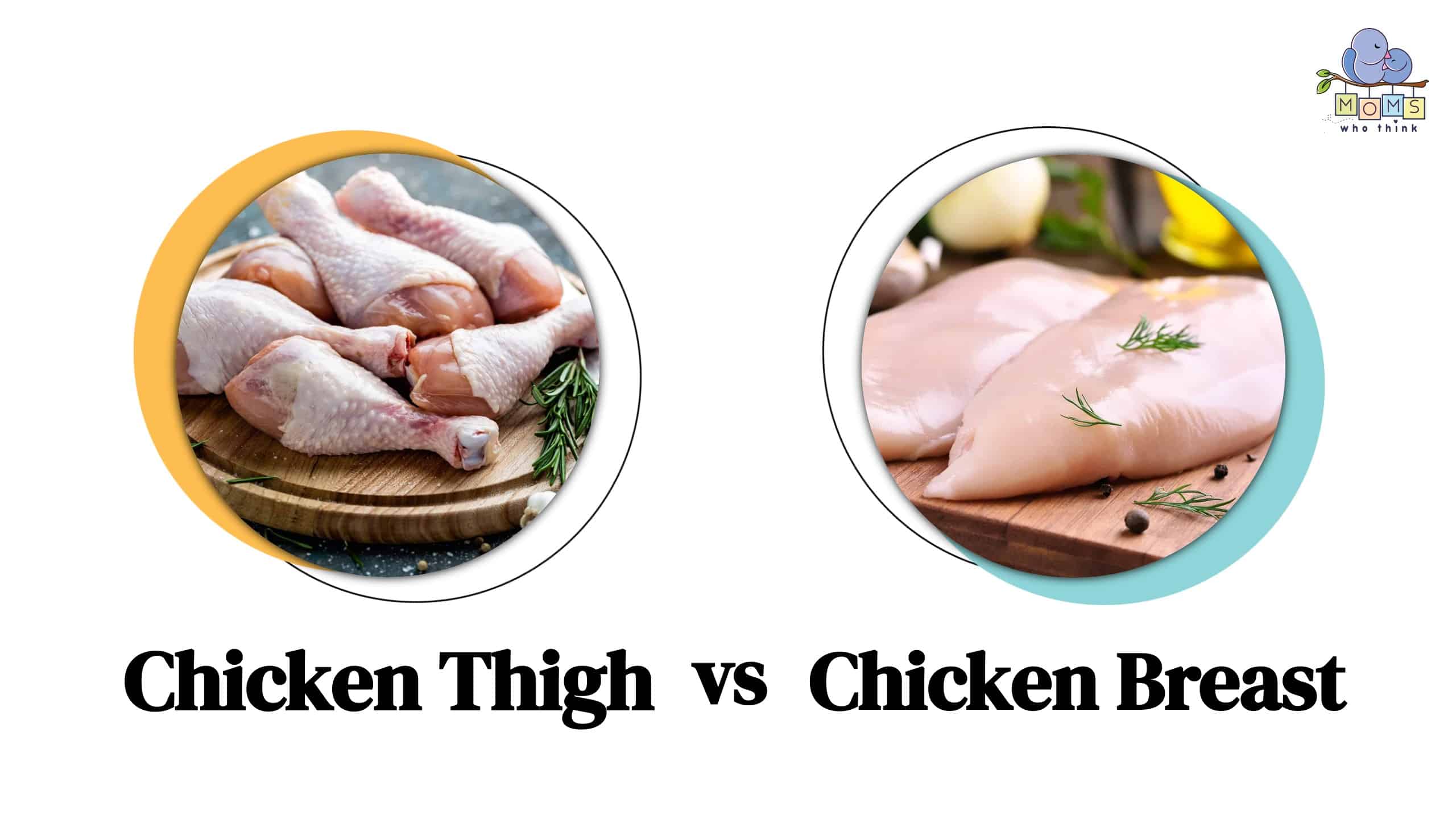Unless you’re roasting a whole chicken at home, you probably buy cuts of chicken meat at the store. The two most popular cuts are chicken thighs and chicken breasts. Even though they're simply different parts of the same animal, there are some differences between chicken thighs vs. breasts.
Chicken thighs are considered dark meat while the chicken breast is white meat. The main difference between dark and white meat is the type of muscle fibers found in that part of the animal. Chicken thighs are higher in fat, juicier, and more flavorful. Chicken breasts, on the other hand, are leaner and have a milder flavor.
- The must-have convenient reference guide for every home cook!
- Includes more than 8,000 substitutions for ingredients, cookware, and techniques.
- Save time and money on by avoiding trips to grab that "missing" ingredient you don't really need.
Keep reading to find out about the differences between chicken thighs and chicken breasts.
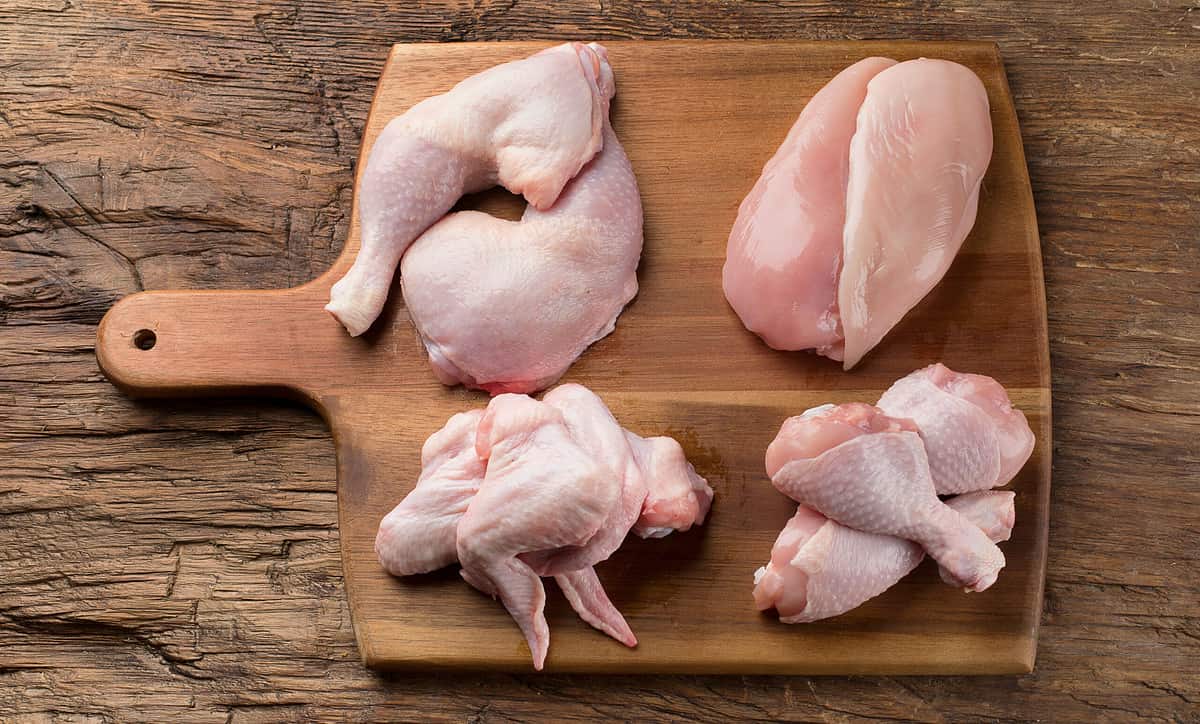
©Tatjana Baibakova/Shutterstock.com
Chicken Thigh vs. Breast: What Is the Difference?
The main difference between chicken thighs and breasts is their flavor and texture. Chicken breasts are lean cuts with a mild, slightly sweet flavor and a firm texture while chicken thighs have a deeper, richer flavor and a more tender, juicy texture that's higher in fat content.
Chicken thighs and breasts are two cuts of meat from different parts of the chicken. The type of muscle fibers found in the different regions impacts the proteins, nutrients, and taste of the meat.
First off, chicken thighs are dark meat and are higher in fat than chicken breast. The higher fat content leads to more flavor, and it also makes chicken thighs easier to cook so even if you cook chicken thighs for a long time, it’s difficult to overcook them.
On the contrary, chicken breasts are white meat and have lower calories than chicken thighs. The leanness of chicken breasts makes them easy to overcook. Since they have a lower fat content, the meat can dry out quickly if cooked too long.
The skin of the chicken can add a lot of flavor to chicken thighs or chicken breasts, but you’re unlikely to find skin-on chicken breasts unless you purchase a whole chicken.
Compared to chicken breasts, chicken thighs are a much more affordable option. You can purchase chicken thighs boneless or bone-in. If you do purchase them with bones, you might consider saving the bones to make homemade chicken stock or bone broth.
What Are Chicken Thighs?

©Sea Wave/Shutterstock.com
Chicken thighs are a cut of meat from the top of the chicken leg. This cut is considered dark meat because of the percentage of red fibers in the meat. Dark meat contains about 50% muscle fibers compared to only 10% red fibers in white meat. The amount of myoglobin, a type of protein found in muscles, contributes to the darker color.
Chicken thighs contain more tendons because they’re dark meat, but this makes it easier to avoid overcooking them. You can cook chicken thighs in numerous ways such as grilling, slow cooking, frying, or roasting. Due to the higher fat content, they are usually more flavorful than chicken breast.
You can also purchase several different types of chicken thighs depending on your preferences. Usually, they’re sold boneless or bone-in, skinless or with the skin on, or as a combination of the two options. If you purchase bone-in chicken thighs, they can be cooked with the bones although this will affect the cooking time.
Chicken thighs are significantly cheaper than purchasing chicken breasts, especially when you buy them bone-in. Generally, bone-in chicken thighs are about a third of the price of boneless, skinless chicken breast.
What Are Chicken Breasts?
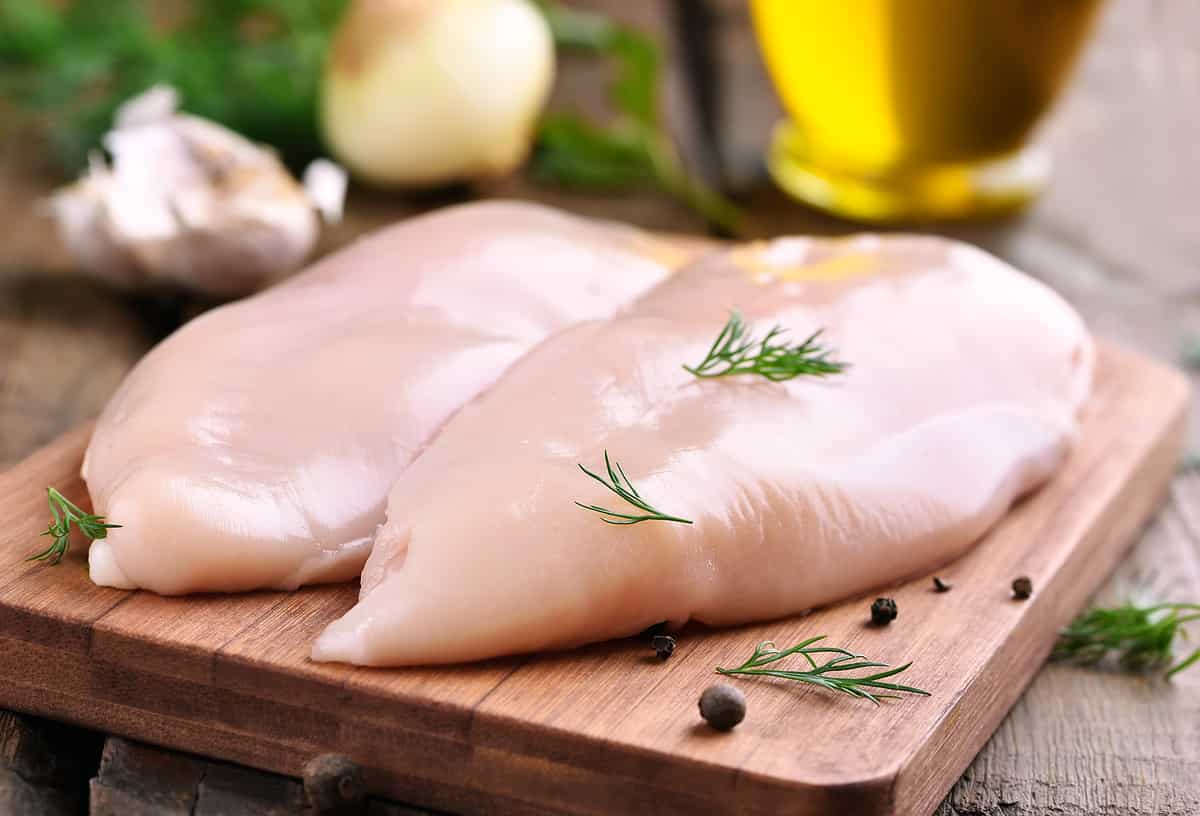
©iStock.com/voltan1
Chicken breasts are a white cut of meat that comes from the breast or pectoral muscle of the chicken. They’re the most popular cut of chicken meat because they’re lean and high in protein.
Although it can be challenging to cook chicken breasts properly without drying them out, chicken breasts are a versatile cut that can be used in a variety of recipes. Chicken breast is also high in vitamin B, vitamin D, calcium, and iron. Additionally, chicken breast has zero carbs and the fat in chicken breast is better than the fat in red meat. This is because red meat has more saturated fat, which can lead to high cholesterol and an increased risk of heart disease.
Chicken breasts can be prepared in a myriad of ways such as baking, frying, sauteing, or grilling. You can add it to pasta or pan-roast it with a diverse range of vegetables.
Boneless and skinless chicken breasts are more expensive than purchasing thighs. However, if you don’t plan on using the bones, the extra cost is likely worth the convenience of being able to easily add them to any recipe.
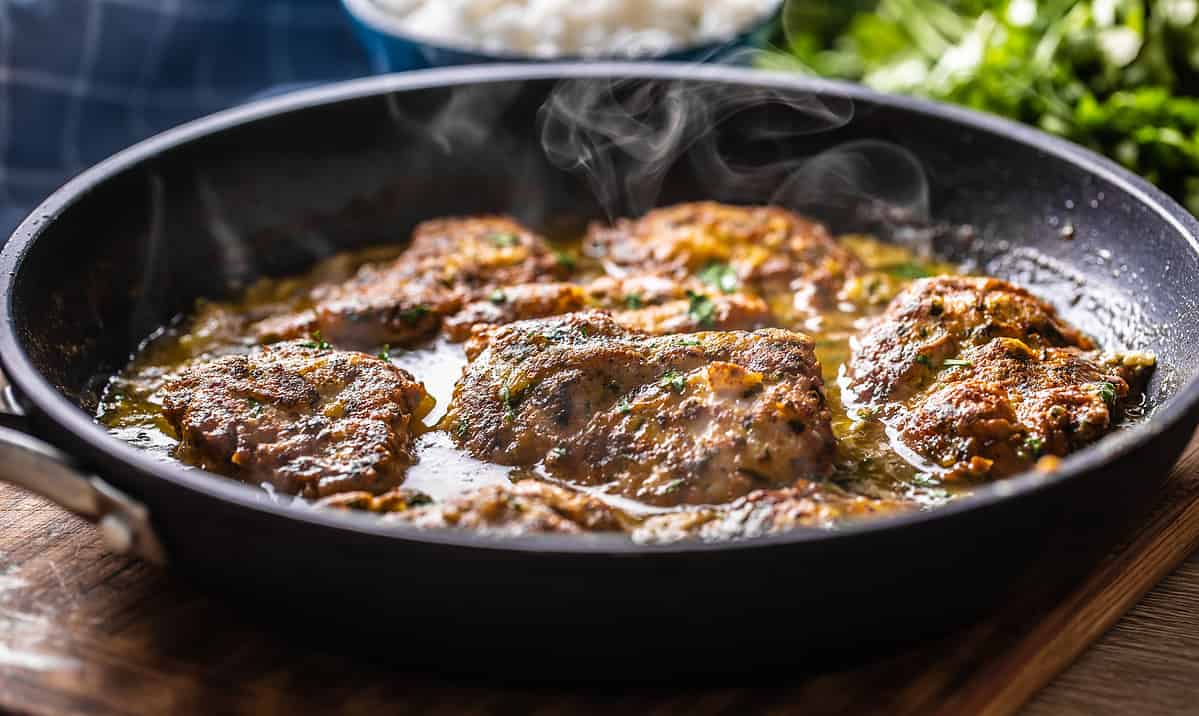
©iStock.com/MarianVejcik
Can You Substitute Chicken Thighs for Chicken Breast?
Chicken thighs and chicken breasts have different vitamins, nutrients, and a difference in flavors, but one can be substituted for the other in most cases. If you prefer white meat over dark meat chicken, you might prefer to switch out the chicken thighs in a recipe for chicken breast or vice versa.
When you substitute chicken thighs for chicken breast, keep the cooking times and method of cooking in mind. Since chicken thighs have a higher fat content, it’s a lot more difficult to overcook thighs and they’re usually juicer even when you cook them for a long time.
Chicken breasts are a lot easier to overcook and they dry out pretty quickly when you cook them too long.
- The must-have convenient reference guide for every home cook!
- Includes more than 8,000 substitutions for ingredients, cookware, and techniques.
- Save time and money on by avoiding trips to grab that "missing" ingredient you don't really need.
Some recipes are going to be better suited for chicken thighs vs. breast. Thighs work well when you need more flavor and fat in the recipe, or when you’re using the slow cooker and don't want the meat to dry out.
Chicken breasts are excellent in a variety of recipes and they can be grilled, stuffed, or even wrapped in bacon to add more flavor! Although, you may want to avoid the bacon if you're looking for a low-fat meal.
Are Chicken Thighs Healthier Than Chicken Breasts?
If you’re trying to decide between using chicken thighs or chicken breasts, you might wonder which one is healthier. Although the nutritional value of chicken thighs vs. chicken breasts is different, one aspect of how healthy they are is going to be how you cook them.
Whether you choose chicken thighs or chicken breasts, they’re not going to be as healthy when fried as they would be if you used a slow cooker (even though fried chicken is delicious!) Aside from how you cook your chicken, skinless chicken breast is going to be leaner with fewer calories and fat than chicken thighs.
Chicken thighs aren’t all bad though, and there are many nutritional benefits to thighs as well. Some nutrients and vitamins in chicken thighs are higher than that of chicken breasts. Boneless, skinless chicken breasts may be lower in calories and fat, but chicken thighs are higher in zinc and potassium, and vitamin A.
If you’re trying to lose weight or are following a low-fat diet, chicken breast will usually be better since it’s much leaner than chicken thighs. If you want to limit the fat found in chicken thighs, you can also make sure they’re skinless since this is an option with fewer calories and fat.
Nutritional Value of Chicken Thigh vs. Chicken Breast
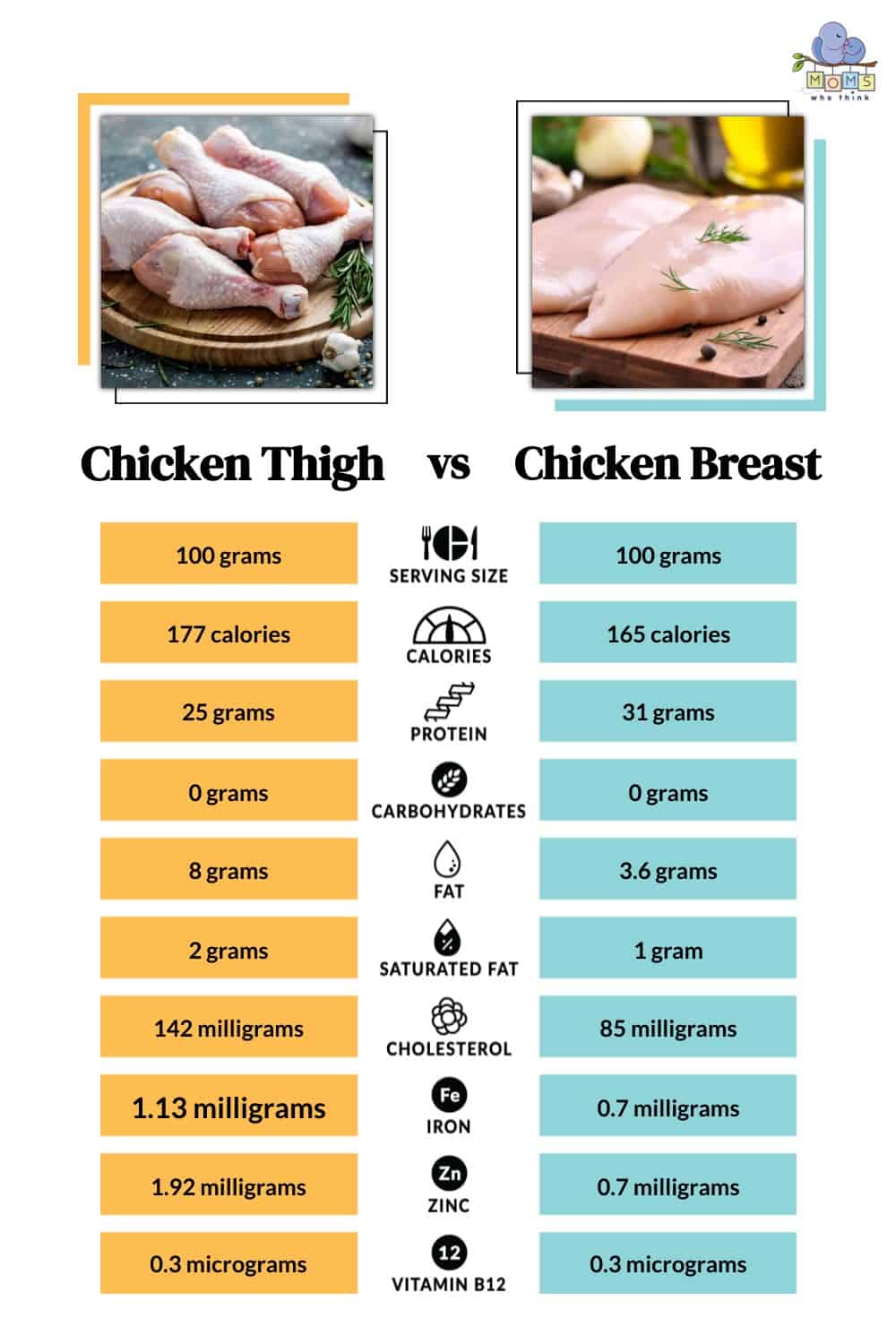
©
Even though chicken thighs and breasts are part of the same animal, they have different nutrients, vitamins, and calories. Chicken breast and thighs, like other poultry, are a great source of nutrients in a balanced diet. Here’s a look at the difference in the nutritional value of a chicken thigh vs. chicken breast:
| Nutritional Values | Chicken Thigh (100 g) | Chicken Breast (100 g) |
| Calories | 177 | 165 |
| Protein | 24.8 g | 31 g |
| Total Fat | 8.15 g | 3.57 g |
| Carbohydrate | 0 g | 0 g |
| Fiber | 0 g | 0 g |
| Sugar | 0 g | 0 g |
| Calcium | 9 mg | 15 mg |
| Iron | 1.13 mg | 1.04 mg |
| Magnesium | 24 mg | 29 mg |
| Phosphorus | 230 mg | 228 mg |
| Potassium | 269 mg | 256 mg |
| Sodium | 106 mg | 74 mg |
| Zinc | 1.92 mg | 1 mg |
| Riboflavin | 0.218 mg | 0.114 mg |
| Vitamin B-12 | 0.42 µg | 0.34 µg |
| Vitamin A, IU | 27 IU | 21 IU |
| Vitamin B-6 | 0.462 mg | 0.6 mg |
| Vitamin E | 0.18 mg | 0.27 mg |
Chicken Thigh Recipes
- Chicken with Potatoes and Tomatoes
- Crock Pot Chicken and Sausage Gumbo
- Skillet Chicken with Yellow Rice
- Skillet Chicken Divine
- Healthy Chicken Nuggets
Chicken Breast Recipes
PrintCrab Stuffed Chicken Breasts
- Yield: 6 servings 1x
Ingredients
Instructions
1. Flatten chicken to ¼ inch thickness; sprinkle with salt and pepper.
2. In a small bowl, combine the crab, water chestnuts, bread crumbs, mayonnaise, parsley, mustard, 2 teaspoons marinade for chicken, and half of the onions.
3. Chop one cheese slice; stir into crab mixture. Spread over chicken; roll up and secure with toothpicks.
4. In a large nonstick skillet coated with cooking spray, brown chicken on all sides. Place seam side down in a shallow 3 qt. baking dish coated with cooking spray. Brush with remaining marinade for chicken.
5. Bake, uncovered, at 350° for 25 minutes. Cut each remaining cheese slice into six strips; place two cheese strips over each chicken breast. Bake 5 to 10 minutes longer or until a meat thermometer reads 170°. Discard toothpicks. Sprinkle remaining onions over chicken.
Nutrition
- Serving Size: 1 stuffed chicken breast half
- Calories: 225
- Sodium: 469mg
- Fat: 7g
- Saturated Fat: 2g
- Carbohydrates: 5g
- Protein: 35g
- Cholesterol: 95mg
- Coca-Cola Chicken Recipe
- Homemade BBQ Chicken Breasts
- Rice Stuffed Chicken Breasts
- Portabello Chicken Breasts
- Veggie Baked Chicken Breasts
Takeaway
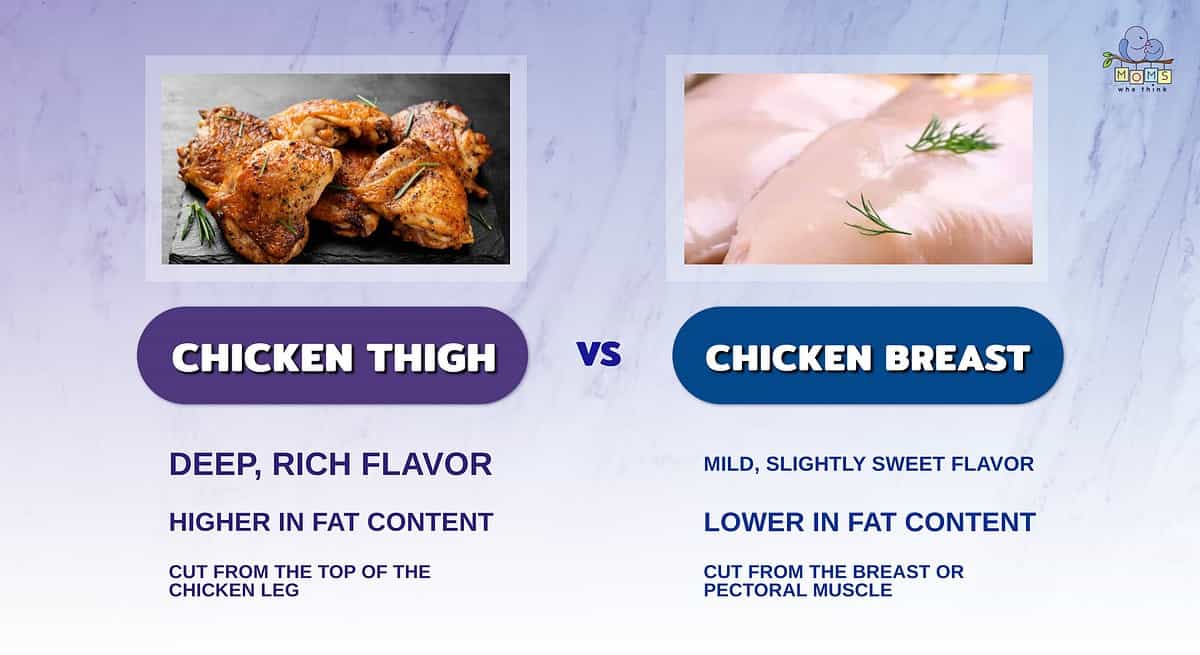
- Chicken thighs have a deep, rich flavor that contrasts the mild sweetness of chicken breasts.
- If you're on a diet, it's a good idea to keep the higher fat content of chicken thighs in mind.
- The location that these two cuts of meat are from differs. Chicken thighs come from the top of the chicken leg, while chicken breast is cut from the breast or pectoral muscle.
Chicken breasts and thighs are both an excellent part of a healthy diet. The biggest difference between chicken thighs and breasts is that chicken thighs are dark meat while chicken breast is white meat. Dark meat is higher in fat and calories, while white meat like chicken breast is leaner and has a milder flavor.
Even though chicken thighs and breasts can be used interchangeably in most recipes, you may need to adjust the cooking times, especially if you substitute chicken breast for chicken thighs. While it’s nearly impossible to overcook chicken thighs, chicken breast is easy to overcook, leading to dry and stringy meat. No matter what you’re in the mood for, there are plenty of delicious chicken recipes out there that the whole family will love.
